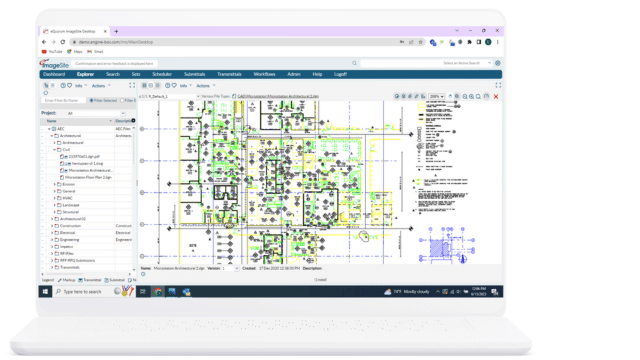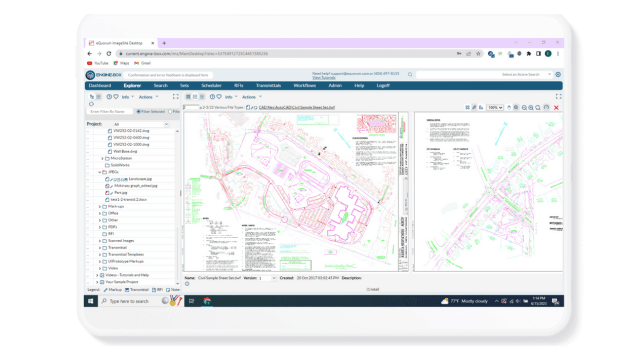How To Simplify the Document Management System Implementation Process
How To Simplify the Document Management System Implementation Process
An engineering document management system (EDMS) can improve productivity, reduce costs, and protect company intellectual property. Implementing new software often can be challenging for unguided companies. But there are ways, however, to simplify the process. Here are several steps that organizations can follow to help with simplifying document management system implementation.
Assigning an administrator
When adopting a document management system, it's important to assign a liaison between the provider of the document management system and your organization. This is the person that oversees the implementation from start to finish. Additionally, you want to ensure team leaders and department heads are clued into the process, as they will be primarily responsible for their team’s/department’s and the handling of such.
Document controllers should also be involved in the process, as they are typically responsible for the management and security of documents and drawings. For many companies, a document controller or several hold the position of system administrator. Involving team and project leads in the implementation process ensures organizations are on the same page, and that cross-functional teams can collaborate successfully and appropriate workflow steps and security are applied.
Establishing an implementation strategy and data structure
Before making the switch to a new document management system, you must first have access to all of your current documents and filing systems. If your company is managing paper documents, make sure to digitize them, or at least have a plan on how to scan and OCR (optical character recognition) them, to import them into the system along with your other digital files.
Next, determine how you want these documents to be stored, including your filing structure and the way you want to present your document metadata. Unfortunately, many organizations simply want to recreate the directory and file structure currently on their share, not realizing that this structure has evolved totally haphazardly over the years, often with little coordination between the creators and the users. The implementation is a great time to re-evaluate this structure and what ultimately makes sense for your organization. Take this moment to review for duplication; old, obsolete projects; and files for users no longer with the organization.
If your document management system provider includes an implementation guide (like eQuorum’s implementation questionnaire), make sure you answer all the questions to the best of your ability, and work with the provider to carefully think through how you want your documents organized for the foreseeable future, not how it has always been.
Make sure you are documenting the process as you determine your directory structure, as this will help those involved in the process better understand your rationale. Keep in mind the differences between departments and projects and the way they manage review and approval processes. You can decide to standardize these processes or configure the system so the processes vary between teams. This should be a group decision that includes all relevant team leads.
It's important to note your organization is not alone in this process, as you can leverage the expertise of document management software providers and their document management implementation specialists. They should be able to help you with the process from digitization to creating your directory structure, to workflows and more.
Identifying documents and metadata
Once you have determined your strategy, you can now start to work on identifying your paper and digital documents and classifying them based on the system you’ve created. The team assigned to implementation should take inventory of the documents, and assign important metadata to each document, mostly automatically, but some may require manual entry. This makes the process easier, as it classifies documents into groups and projects. This stage will also help you identify gaps in information required for implementation. During the process you may also identify indexing data that is no longer required or is out of date. Often, organizations are entering and keeping metadata that is not even used simply because they have always done it that way. In addition, many systems provide free text search whereby the text within documents and drawings are automatically indexed, giving users the ability to search for needed documents without the need for applicable metadata.

The Discipline of Workflow Schedule Management
Business operations seem more chaotic than ever. The economic swings seem bigger; the labor pool is tighter, more diverse, and more geographically dispersed; the amount of information is enormous; and at the end of the day, management has just become harder. Trying to get your arms around all that’s going on and ensuring the organization is focused on getting the tasks done is now more complex and daunting. Add pandemics, supply chain disruptions, geopolitical uncertainty, and now even historical inflation.
What is a manager to do?
Creating processes and workflows
Have all teams using the system ensure the established structure is easily understood by all project members, since having a system that’s intuitive for team leaders guarantees team members can access and manage their files and documents efficiently.
Implementing a document management system with integrated workflow capabilities creates a significant advantage for engineering-based companies, as engineers often are required to handle a multitude of review and approval processes. Creating a high-quality engineering workflow guarantees engineers have a complete understanding of their part in a workflow, leading to reductions in the amount of time it takes to handle a document. This not only simplifies tasks for workflow participants but can also increase productivity, resulting in a higher return on investment.
Purging outdated documents
Once you have developed an outline for your document management system, you should spend some time looking for the documents you don’t need. (One estimate is that up to 60 percent of all documents put into a new document management system are obsolete or unneeded.) A document management system is designed to reduce clutter, so you should remove unnecessary or unwanted documents from the equation.
Teams may decide to add dated documents to a company archive or create a separate location within the document management system to store historical documents. Your organization may be legally required to keep some documents in the system, so you mustn’t delete any of the files until you have confirmation they are no longer needed and no one will need to access them in the future.
Implementing an engineering document management system (EDMS)
When implementing an on-premise EDMS system, you will need to supply a server or VM to run the webserver software (Apache Tomcat), and a server or VM to run the software and the database. On the other hand, EngineBox, eQuorum’s cloud EDMS doesn’t require you to own or maintain any servers, making implementation incredibly simple.
When implementing any software, you should assign a system administrator or application owner, who will create and manage user profiles of employees and other users (e.g., vendors, contractors, and customers). Once the system admin has made the profiles and set user permissions for each project, eQuorum steps in to ensure quick and seamless implementation.
eQuorum’s implementation specialists help organizations with various elements of implementation, including system access and configuration, workflow automation, creating and uploading transmittal templates, and bulk document upload. Additionally, eQuorum will help you set up CAD connectors and other integrations, to ensure your system is working seamlessly with other software. Lastly, eQuorum will help configure user access control and will provide administrators and users with the training they need to manage and use the system moving forward.
Depending on the number of files and documents your company has, implementation can take weeks. With expert help like that provided by eQuorum’s implementation specialists, however, this process can be shortened to a matter of days. If you would like to learn more about ImageSite and EngineBox, please click here. If you would like to learn more about implementing these systems, click here. Or, if you would like to schedule a free trial or demo, click here.
Additional EDMS Features
Our EDMS solutions
ImageSite and EngineBox are eQuorum’s robust workflow and document management solutions, created to help workers manage their essential workflows while maintaining complete control over their engineering files and documents. Not only do they provide a secure collaboration site for workers, but they also help organizations manage document distribution with third parties like vendors, contractors, and customers. Both systems are offered at a competitive price, enabling organizations to get a quick return on their investment by providing the features and functionality needed to help organizations improve efficiency, productivity, and collaboration. Companies can choose from concurrent user subscriptions or named user subscriptions, ensuring organizations have subscription options that make sense for their business.

ImageSite®
Our single source engineering workflow and document management system. Built in HTML5 so there is no software to deploy to client computers or mobile apps to download. Offered as an On-premise or Private Cloud system.
EngineBox™
EngineBox is a cloud based workflow and document management version of ImageSite that resides outside the corporate network.
Our EDMS solutions
ImageSite and EngineBox are eQuorum’s robust workflow and document management solutions, created to help workers manage their essential workflows while maintaining complete control over their engineering files and documents. Not only do they provide a secure collaboration site for workers, but they also help organizations manage document distribution with third parties like vendors, contractors, and customers. Both systems are offered at a competitive price, enabling organizations to get a quick return on their investment by providing the features and functionality needed to help organizations improve efficiency, productivity, and collaboration. Companies can choose from concurrent user subscriptions or named user subscriptions, ensuring organizations have subscription options that make sense for their business.

EngineBox™
EngineBox is a cloud based workflow and document management version of ImageSite that resides outside the corporate network.
The eQuorum Customer Promise
In 2005, eQuorum developed the first all browser-based EDMS. The system, although for on-premise use, was still created to remove client software and JAVA from user computers and allow users to have a single viewer based on the simple navigation functionality of browsers. Today, eQuorum provides that same application in a private Cloud or a SaaS Cloud option. We can do this because we are, and have always been, browser-based, understanding the enhanced speed, security, and usability of this technology.
With the abundance of document management systems on the market today, there’s no doubt that choosing the right Cloud document management software can be a difficult decision. eQuorum is here to provide a comprehensive, powerful, and most importantly – affordable Cloud document management solution. We believe in providing real value to our customers by eliminating unnecessary costs, providing industry-leading functionality, and equipping your team with the right tools using cutting edge technology to bring your products to market faster.
eQuorum®
We specialize in engineering workflow and document management. Our comprehensive, yet easy-to-use software provides the solution to manage data from design to manufacturing and production, to sales, support and administration.